
Triceratops is a genus of chasmosaurine ceratopsian dinosaur that lived during the late Maastrichtian age of the Late Cretaceous period, about 68 to 66 million years ago in what is now western North America. It was one of the last-known non-avian dinosaurs and lived until the Cretaceous–Paleogene extinction event 66 million years ago. The name Triceratops, which means 'three-horned face', is derived from the Greek words trí- meaning 'three', kéras meaning 'horn', and ṓps meaning 'face'.

Chasmosaurus is a genus of ceratopsid dinosaur from the Late Cretaceous Period in North America. Its given name means 'opening lizard', referring to the large openings (fenestrae) in its frill. With a length of 4.3–4.8 metres (14.1–15.7 ft) and a weight of 1.5–2 tonnes —or anywhere from 2,200 to nearly 5,000 lbs., give or take—Chasmosaurus was of a slightly smaller to ‘average’ size, especially when compared to larger ceratopsians. The Chasmosaurs were similar, in overall build and weight, to a white rhinoceros or an Indian rhinoceros; just like rhinos, and all other ceratopsians, they were purely herbivorous, needing to consume around 54 kilograms, or 120 lbs., of plant matter each day.

Ceratopsidae is a family of ceratopsian dinosaurs including Triceratops, Centrosaurus, and Styracosaurus. All known species were quadrupedal herbivores from the Upper Cretaceous. All but one species are known from western North America, which formed the island continent of Laramidia during most of the Late Cretaceous. Ceratopsids are characterized by beaks, rows of shearing teeth in the back of the jaw, elaborate nasal horns, and a thin parietal-squamosal shelf that extends back and up into a frill. The group is divided into two subfamilies—Chasmosaurinae and Centrosaurinae. The chasmosaurines are generally characterized by long, triangular frills and well-developed brow horns. The centrosaurines had well-developed nasal horns or nasal bosses, shorter and more rectangular frills, and elaborate spines on the back of the frill.

Pentaceratops is a genus of herbivorous ceratopsid dinosaur from the late Cretaceous Period of what is now North America. Fossils of this animal were first discovered in 1921, but the genus was named in 1923 when its type species, Pentaceratops sternbergii, was described. Pentaceratops lived around 76–73 million years ago, its remains having been mostly found in the Kirtland Formation in the San Juan Basin in New Mexico. About a dozen skulls and skeletons have been uncovered, so anatomical understanding of Pentaceratops is fairly complete. One exceptionally large specimen later became its own genus, Titanoceratops, due to its more derived morphology, similarities to Triceratops, and lack of unique characteristics shared with Pentaceratops.
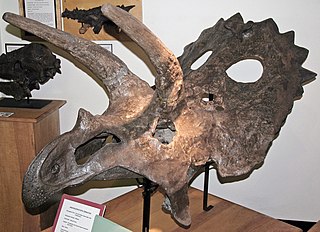
Anchiceratops is an extinct genus of chasmosaurine ceratopsid dinosaur that lived approximately 72 to 71 million years ago during the latter part of the Cretaceous Period in what is now Alberta, Canada. Anchiceratops was a medium-sized, heavily built, ground-dwelling, quadrupedal herbivore that could grow up to an estimated 4.3 metres (14 ft) long. Its skull featured two long brow horns and a short horn on the nose. The skull frill was elongated and rectangular, its edges adorned by coarse triangular projections. About a dozen skulls of the genus have been found.

Medusaceratops is an extinct genus of centrosaurine ceratopsian dinosaur known from the Late Cretaceous Judith River Formation of Montana, northern United States. It contains a single species, Medusaceratops lokii.

Coahuilaceratops is a genus of ceratopsian dinosaur. It is a chasmosaurine ceratopsian which lived during the Late Cretaceous period in what is now southern Coahuila in northern Mexico. It is known from the holotype CPC 276, a partial skeleton of an adult individual which includes several skull elements. Another specimen, CPS 277, may represent a juvenile Coahuilaceratops. All specimens of Coahuilaceratops were collected from a single location in the middle strata of the Cerro del Pueblo Formation, which dates to between 72.5 and 71.4 million years ago.
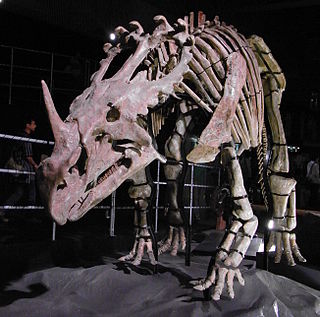
Sinoceratops is an extinct genus of ceratopsian dinosaur that lived approximately 73 million years ago during the latter part of the Cretaceous Period in what is now Shandong province in China. It was named in 2010 by Xu Xing et al. for three skulls from Zhucheng, China. The name of its type species Sinoceratops zhuchengensis means "Chinese horned face from Zhucheng", after the location of its discovery.

Kosmoceratops is a genus of ceratopsid dinosaur that lived in North America about 76–75.9 million years ago during the Late Cretaceous period. Specimens were discovered in Utah in the Kaiparowits Formation of the Grand Staircase–Escalante National Monument in 2006 and 2007, including an adult skull and postcranial skeleton and partial subadults. In 2010, the adult was made the holotype of the new genus and species Kosmoceratops richardsoni; the generic name means "ornate horned face", and the specific name honors Scott Richardson, who found the specimens. The find was part of a spate of ceratopsian discoveries in the early 21st century, and Kosmoceratops was considered significant due to its elaborate skull ornamentation.

Vagaceratops is a genus of herbivorous ceratopsian dinosaur. It is a chasmosaurine ceratopsian which lived during the Late Cretaceous period in what is now Alberta. Its fossils have been recovered from the Upper Dinosaur Park Formation. It is sometimes included in the genus Chasmosaurus as Chasmosaurus irvinensis instead of being recognized as its own genus.
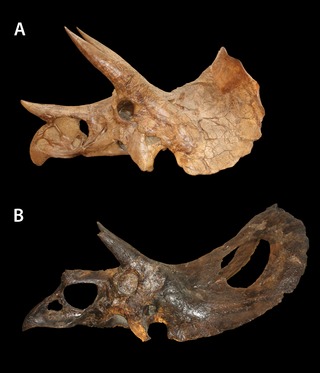
Triceratopsini is a tribe of herbivorous chasmosaurine dinosaurs that lived between the late Campanian to the late Maastrichtian stages of the Cretaceous period, between 74.73 and 66 million years ago. Fossils of these animals have been found in western North America, in particular West Canada, Western and Midwestern United States, which was once part of the ancient continent of Laramidia. The tribe was named by Nicholas R. Longrich in 2011 for the description of Titanoceratops, which he defined as "all species closer to Triceratops horridus than to Anchiceratops ornatus or Arrhinoceratops brachyops". Triceratopsins were the largest of the chasmosaurines; suggesting that gigantism had evolved in the Ceratopsidae once. In addition there is an evolutionary trend in the solidification of the frills, the most extreme being in Triceratops.

Nasutoceratops is genus of ceratopsid dinosaur that lived in North America during the Late Cretaceous period, about 76.0–75.5 million years ago. The first known specimens were discovered in Utah in the Kaiparowits Formation of the Grand Staircase–Escalante National Monument (GSENM) from 2006 onwards, including a subadult skull with a partial postcranial skeleton and rare skin impressions and two other partial skulls. In 2013, the subadult was made the holotype of the new genus and species Nasutoceratops titusi; the generic name means "large-nosed horned face", and the specific name honors the paleotologist Alan L. Titus for his work at the GSENM. The dinosaur was noted for its large nose in news reports, and later featured in Jurassic World films.

Coronosaurus is a genus of centrosaurine ceratopsian dinosaurs which lived in the Late Cretaceous, in the middle Campanian stage. Its remains, two bone beds, were discovered by Phillip J. Currie in the Oldman Formation of Alberta, Canada, and its type and only species, Coronosaurus brinkmani, was first described in 2005, as a new species within the genus Centrosaurus. Later studies questioned the presence of a direct relationship, and in 2012 it was named as a separate genus. Coronosaurus means "crowned lizard", coming from "corona", Latin for crown, and "sauros", Greek for lizard; this name refers to the unique, crown-like shape of the horns on the top of its frill.

Judiceratops is an extinct horned dinosaur. It lived around 78 million years ago, during the Late Cretaceous Period in what is now Montana, United States. Like other horned dinosaurs, Judiceratops was a large, quadrupedal herbivore. It is the oldest known chasmosaurine.

Bravoceratops is a genus of large chasmosaurine ceratopsid dinosaur that lived approximately 70 million years ago, and is known from the Late Cretaceous Javelina Formation in what is now Texas, United States.

This timeline of ceratopsian research is a chronological listing of events in the history of paleontology focused on the ceratopsians, a group of herbivorous marginocephalian dinosaurs that evolved parrot-like beaks, bony frills, and, later, spectacular horns. The first scientifically documented ceratopsian fossils were described by Edward Drinker Cope starting in the 1870s; however, the remains were poorly preserved and their true nature was not recognized. Over the next several decades, Cope named several such genera and species. Cope's hated rival, Othniel Charles Marsh, also described ceratopsian remains. In 1887, Marsh mistook a Triceratops horn for one belonging to a new species of prehistoric Bison. Marsh also named the eponymous genus Ceratops in 1888. The next year, he named the most famous ceratopsian, Triceratops horridus. It was the discovery of Triceratops that illuminated the ceratopsian body plan, and he formally named the Ceratopsia in 1890.
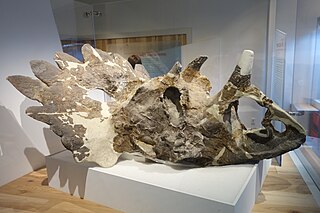
Regaliceratops is a monospecific genus of chasmosaurine ceratopsid dinosaur from Alberta, Canada that lived during the Late Cretaceous in what is now the St. Mary River Formation. The type and only species, Regaliceratops peterhewsi, is known only from an adult individual with a nearly complete skull lacking the lower jaw, which was nicknamed "Hellboy". Regaliceratops was named in 2015 by Caleb M. Brown and Donald M. Henderson. Regaliceratops has an estimated length of 5 metres (16 ft) and body mass of 2 metric tons. The skull of Regaliceratops displays features more similar to centrosaurines, which suggests convergent evolution in display morphology in ceratopsids.
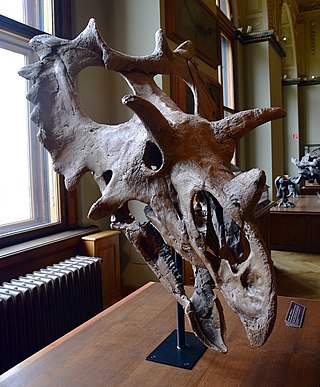
Spiclypeus is an extinct genus of chasmosaurine ceratopsian dinosaur known from the Late Cretaceous Judith River Formation of Montana, United States.
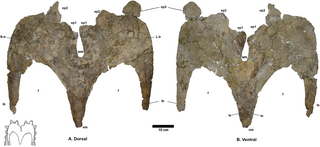
Terminocavus is a genus of ceratopsid dinosaur from the late Cretaceous Period of what is now North America. The genus contains a single species, the type species Terminocavus sealeyi, known from a parietal and some other associated fragments. The holotype specimen was discovered in the Kirtland Formation of New Mexico in 1997, and was later described and named in a 2020 study. It was similar in anatomy to Pentaceratops and Anchiceratops, which it was closely related to, but had a distinctive heart-shaped upper frill with very narrow notch. It has been hypothesized to form an anagenetic series with several other chasmosaur species.

Navajoceratops is a genus of ceratopsid dinosaur from the late Cretaceous Period of what is now North America. The genus contains a single species, N. sullivani, named after Robert M. Sullivan, leader of the expeditions that recovered the holotype.
























